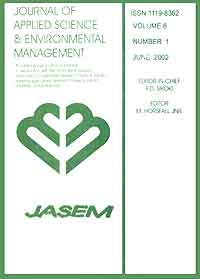
|
Journal of Applied Sciences and Environmental Management
World Bank assisted National Agricultural Research Project (NARP) - University of Port Harcourt
ISSN: 1119-8362
Vol. 12, No. 3, 2008, pp. 95-100
|
 Bioline Code: ja08055
Bioline Code: ja08055
Full paper language: English
Document type: Research Article
Document available free of charge
|
|
|
Journal of Applied Sciences and Environmental Management, Vol. 12, No. 3, 2008, pp. 95-100
| en |
Decrease in Activities of Selected Rat Liver Enzymes following Consumption of Chemical Effluent
Oloyede, O.B. & Sunmonu, T.O.
Abstract
The effects of the chemical effluent from Soap and Detergent Industry on some rat liver
enzymes were investigated. Chemical analyses of both the effluent and tap water which served as the control were
carried out before various concentrations of the effluent (5%v/v, 25%v/v, 50%v/v and 100%v/v) were made. The
effluent as collected from source represents 100%v/v. Four groups of five (5) rats each were placed on the four
concentrations of the effluent prepared as the only source of water for thirty (30) days. The rats in the fifth group
which served as the control were placed on tap water for the same period of time. All the rats were maintained on
commercial rat chow for the duration of the experiment. At the end of the experiment, the animals were sacrificed
and blood samples were collected. The effect of the chemical effluent on rat liver was monitored by conducting
standard enzyme assays for alkaline phosphatase (ALP), alanine transaminase (ALT), aspartate transaminase
(AST) and lactate dehydrogenase (LDH) in the liver and serum of experimental animals. Relative to the control,
significant (p<0.05) decrease in the activity of the liver enzymes and significant (p<0.05) increase in the activity of
the serum enzymes studied were observed in all the test rats with the effect most significant in the 100%v/v group
of rats. On the whole, chemical effluent from Soaps and Detergent Industry may impair liver function and could
pollute any river that serves as a recipient to it.
|
| |
© Copyright 2008 - Journal of Applied Sciences & Environmental Management
|
|
